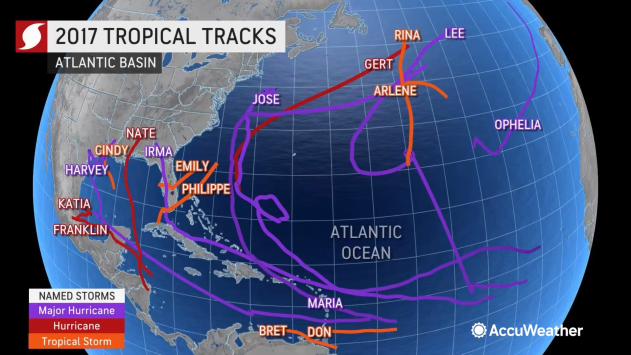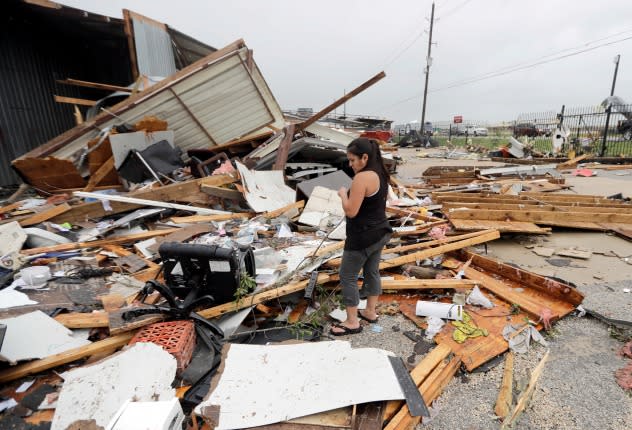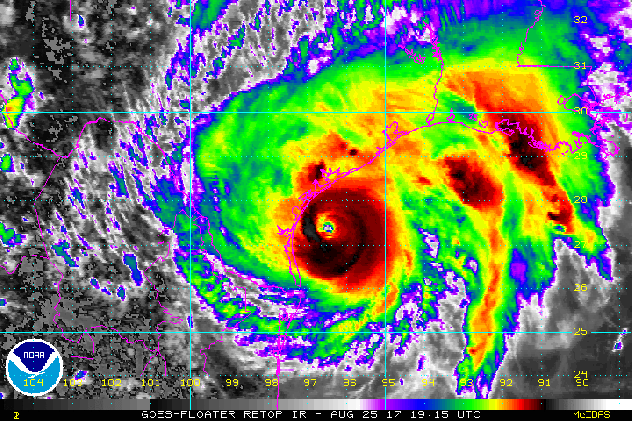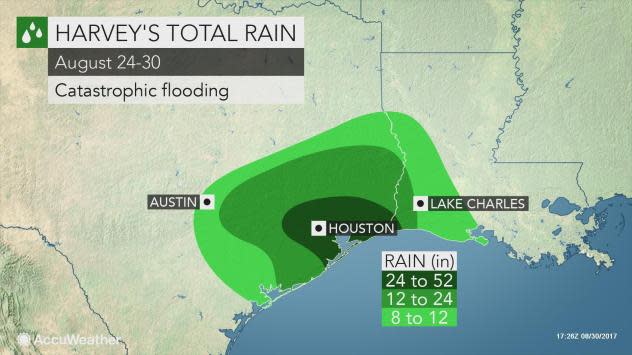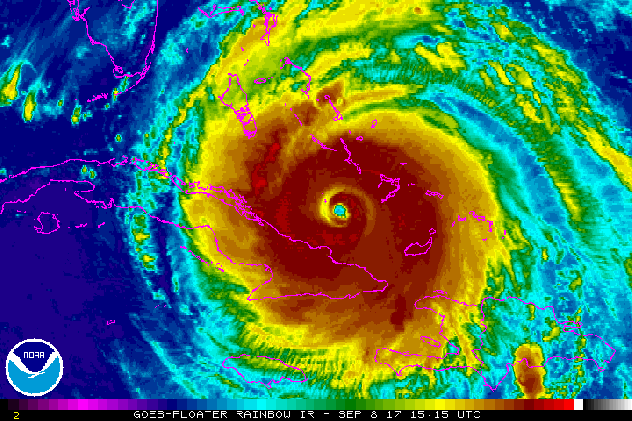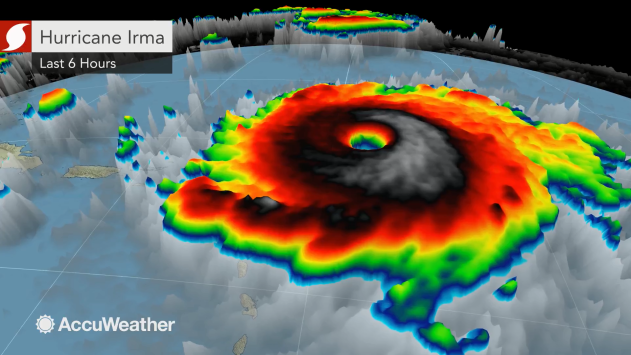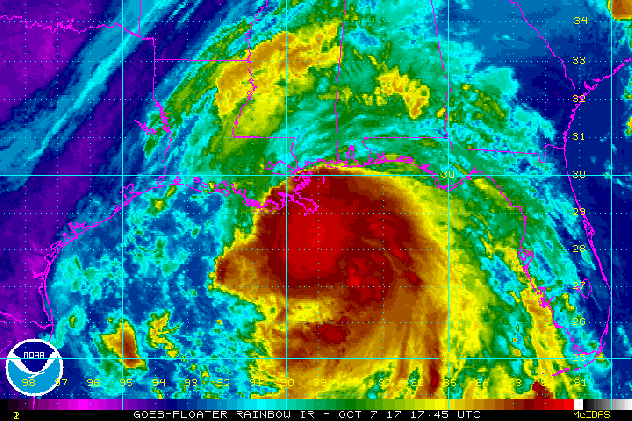Harvey, Irma, then Maria: How the 2017 hurricane season became one of the worst on record
When weather historians and meteorologists think of the most severe hurricane seasons on record, those that come to mind include the 2004 and 2005 seasons, which featured the deadly Category 5 storms Hurricane Katrina, Wilma and Ivan. But one recent season has joined the conversation as one of the most historic to ever take place -- the 2017 Atlantic hurricane season.
From start to finish, the 2017 season unleashed several record-breaking storms, and the season as a whole tops the charts as the costliest of all time, causing nearly $300 billion in damage ($354 billion in 2021 CPI), according to an AccuWeather estimate at the time.
The Atlantic hurricane season officially begins on June 1 every year, but 2017 had a very early start when Tropical Storm Arlene formed in mid-April. Arlene became only the second tropical storm on record to form in the month of April, with the only other being Ana in 2003.
 |
When the season officially began on June 1, it took less than three weeks for the basin to churn out the second and third named storms of the season. By the end of July, five named storms had formed in the Atlantic.
As the calendar turned from July to August, Tropical Storm Franklin strengthened into a hurricane off the coast of Veracruz, Mexico. Then on Aug. 9, Franklin became the first hurricane of the season. About one week later, on Aug. 16, another storm churning in the basin, Gert, strengthened into a Category 2 hurricane. The most active part of the 2017 season had just begun, and for the next several weeks, all eyes would be on the Atlantic as storm after storm continued to form.
As the first Category 2 storm of the season continued to track northeastward on Aug. 16, a tropical depression that would soon become one of the three most severe hurricanes of the year formed far out over the Atlantic Ocean.
 |
Jennifer Bryant looks over the debris from her family business destroyed by Hurricane Harvey Saturday, Aug. 26, 2017, in Katy, Texas. Harvey rolled over the Texas Gulf Coast on Saturday, smashing homes and businesses and lashing the shore with wind and rain so intense that drivers were forced off the road because they could not see in front of them. (AP Photo/David J. Phillip) |
 |
Satellite loop of Hurricane Harvey as it made landfall on the Texas coast in August 2017. (Images/NOAA) |
Harvey was first designated as a tropical depression on Aug. 16 when it was about 440 miles east of Barbados and strengthened into a tropical storm within 12 hours.
Initially, Harvey peaked with top sustained wind speeds of 40 mph on Aug. 18, the same day it crossed over Barbados and St. Vincent in the eastern Caribbean. As northerly wind shear increased, Harvey weakened into a depression and nearly dissipated altogether while moving over the Yucatan. But enough of Harvey's energy survived the hostile conditions as it moved into the Gulf of Mexico to set the stage for a devastating second act.
Rapid intensification began on Aug. 23 as the system moved over very warm water in the Gulf and into an area with light wind shear.
A large mass of deep convection that formed over the center of the system fueled its intensification, and an eye became more defined. Harvey officially became a hurricane that day and boasted a well-defined eye by that night. By then, it was packing 85-mph sustained winds and was lurking 250 miles south of Corpus Christi, Texas, according to National Hurricane Center (NHC records). Its forward speed at that point was 10 mph as it headed for the Texas coastline.
 |
Observed rainfall from Harvey. (Images/NOAA) |
While over the Gulf, Harvey went through a period of explosive intensification, strengthening from a tropical depression into a Category 4 hurricane within 48 hours, according to the National Weather Service.
Harvey first made landfall in Texas near Rockport on Aug. 25 at 10 p.m., local time, at peak intensity with 130-mph sustained winds. Its landfall in Texas made Harvey the first Category 4 storm to strike the state since Carla in 1961 and the first in the United States since Charley in 2004. Wind gusts in Rockport reached as high as 150 mph.
After making landfall, Harvey's forward speed drastically slowed to as low as 2 mph as it lurched in an east-northeasterly direction. Harvey pummeled South Texas with torrential rains as its wind speeds decreased, taking it down to tropical storm status. The drastic slowdown helped amplify its impacts from excess rain and flooding over multiple days. From the time Harvey first made landfall in Texas to when it exited the state as a tropical storm, 57 hours had passed, making it the most significant tropical cyclone rainfall event in United States history, according to the NHC.
After days of tropical downpours, Harvey officially broke Amelia's record from 1978 for the most rainfall ever recorded by an Atlantic tropical cyclone. Nederland, Texas, reported an astounding 60.58 inches of rain from Harvey, which far surpassed the old cyclonic record of 48 inches. Rainfall reports of 50 inches or more were spread over a wide swath of southeastern Texas.
In total, Harvey was blamed for 91 deaths and $198 billion in damage. It was the first major hurricane the United States had seen in more than 10 years, and the Atlantic basin wasn't finished. It took only about two weeks for yet another major hurricane to make landfall on U.S. soil.
 |
A satellite loop of Hurricane Irma moving between the Bahamas and Cuba on the afternoon of Sep. 8, 2017 |
On the heels of Hurricane Harvey came Irma, which formed as a tropical depression off the coast of Africa on Aug. 28 while Harvey was still impacting the Gulf Coast. Irma strengthened into a tropical storm on Aug. 30 and continued intensification as it moved west across the Atlantic Ocean.
Environmental conditions helped Irma rapidly strengthen as it moved over warm water, and it quickly escalated into a hurricane just 30 hours after becoming a tropical depression. Less than 24 hours later, it was a Category 3 hurricane. Irma's sustained wind speeds had intensified by a factor of 80 mph over a 48-hour period, a feat achieved by about only one in 30 Atlantic tropical cyclones, according to the NHC.
On Sept. 5, Irma reached its maximum intensity as a Category 5 storm with sustained winds of 185 mph about 70 miles east-southeast of Barbuda. The Category 5 storm made landfall on the island about 10 hours later, damaging or destroying 95% of all structures there. Some residential blocks were completely flattened, with property damage amounting to about $300 million for the island.
It wasn't just how fast Irma had intensified that was remarkable, but also how long it retained high strength. Irma packed maximum sustained winds of 185 mph for 37 hours, the longest any hurricane ever recorded has maintained that intensity, according to Philip Klotzbach, a Colorado State University meteorologist. Irma also remained at Category 5 strength for three consecutive days, the longest an Atlantic basin storm has done so during the satellite era.
 |
When Irma impacted the Caribbean islands, wind gusts were hard to gauge due to a lack of surviving equipment. In Puerto Rico, more than 70% of Puerto Rico Electric Power Authority customers lost power.
In the Florida Keys, Irma caused major damage and storm surge as high as 8 feet, according to the NHC. Irma also made landfall in the South Florida peninsula as a Category 3 storm, causing extensive damage along the coast. At least 84 people were killed from storm-related incidents from Irma, and more than 7.7 million homes and businesses lost power. Miami-Dade County lost about 50% of its crops, and flooding from the storm spread to downtown Miami.
"It's kind of unusual to see both Texas and Florida be hit by two different, monster hurricanes in the same year," said AccuWeather Hurricane Expert Dan Kottlowski.
Irma was responsible for widespread devastation across several areas and was one of the strongest and costliest hurricanes on record for the Atlantic, according to the NHC. Hurricane Irma caused an estimated $52.1 million in damage, becoming the sixth-costliest Atlantic hurricane of all time.
 |
A satellite loop of Hurricane Maria moving over Puerto Rico on Sep. 21, 2017 |
In echoes of Irma's lengthy parade across the Atlantic, the next notable tropical threat to develop brewed in a similar manner from a tropical wave that emerged off the western coast of Africa. Just days after Irma dissipated over the U.S., a tropical depression formed, and within six hours, it strengthened into Tropical Storm Maria over the central Atlantic on Sept. 16. One day later, Maria became a hurricane.
After that, Maria underwent explosive intensification, strengthening from a Category 1 storm with 85 mph maximum sustained winds on Sept. 17 into a Category 5 hurricane with maximum sustained winds of 165 mph on Sept. 18 -- nearly doubling its max wind speeds within a day's time.
Shortly after becoming a dangerous Category 5 storm, Maria made landfall in Dominica and became the first hurricane of that intensity on record to strike the island. The rainfall from Maria caused several landslides in Dominica and delivered the most extreme winds to ever impact the island, according to USA Today. Maria also caused destruction in the U.S. Virgin Islands.
"I observed 130-mph-plus winds over the Virgin Islands for at least three hours. No wonder all vegetation, especially trees, were blown over across most of these islands," Kottlowski said.
As Maria crossed over Dominica, it weakened slightly to a Category 4 storm but quickly intensified back into a Category 5 and reached its peak intensity with maximum sustained winds of 175 mph. Maria made landfall near Yabucoa, Puerto Rico, as a Category 4 storm packing 155-mph winds -- the strongest hurricane to impact Puerto Rico since 1932.
Maria had dire impacts on Puerto Rico and caused widespread flooding and damage to the island. Many residents said water levels rose to six feet in just 30 minutes, according to The New York Times. The territory's power grid was completely destroyed and left every resident without power.
The Puerto Rico NEXRAD weather radar recorded winds of about 145 mph before being destroyed. Communication to and within Puerto Rico was extremely difficult following Maria as 95% of cell networks were down, and 85% of phone and internet cables above ground were knocked out.
The loss of life was staggering after the monster storm slammed Puerto Rico. Although the initial death toll was significantly underreported, nearly 3,000 people were killed during the hurricane's rampage and in the horrific aftermath of the storm. The hurricane also imposed an economic loss of $90 billion in damages.
"Maria will go down in history as one of the worst storms, if not the worst storm, to ever hit Puerto Rico," said Kottlowski.
 |
Hurricane Nate makes landfall on the Gulf Coast on Oct. 7, 2017 |
Even though Harvey, Irma and Maria were the heaviest hitters to land, other storms became notable in the basin. When Hurricane Jose strengthened into a Category 4 hurricane on Sept. 8, it became the first time on record that two Atlantic hurricanes had sustained winds of at least 150 mph simultaneously. Jose would eventually peak at 155 mph on Sept. 9 and caused minor flooding and damages of about $500,000 to the U.S. Virgin Islands.
After Maria dissipated in late September, the 2017 Atlantic Hurricane season continued to break records through the fall.
In early October, Nate strengthened into a hurricane north of Honduras and then reached a forward speed of 29 mph, the fastest ever recorded over the Gulf of Mexico. Nate unleashed heavy precipitation in Central America and damaged thousands of homes in Costa Rica and Nicaragua. Despite peaking as a Category 1 storm, at least 50 fatalities were blamed on Nate, and the storm cut off drinking water to nearly 500,000 people.
The next storm in the Atlantic, Ophelia, formed over abnormally warm water near the Azores, an island chain in the middle of the Atlantic, west of Portugal. Ophelia strengthened into a Category 3 hurricane on Oct. 14 with maximum sustained winds of 115 mph. Ophelia remained a major hurricane as it passed south of the Azores archipelago, becoming the easternmost major hurricane in the Atlantic basin on record. After losing its hurricane status, the storm remained powerful and produced the highest wind gust ever reported in Ireland at 119 mph.
Want next-level safety, ad-free? Unlock advanced, hyperlocal severe weather alerts when you subscribe to Premium+ on the AccuWeather app. AccuWeather Alerts™ are prompted by our expert meteorologists who monitor and analyze dangerous weather risks 24/7 to keep you and your family safer.
Correction: An earlier version of this story misstated the location of the Azores. The islands are located to the west of Portugal.
